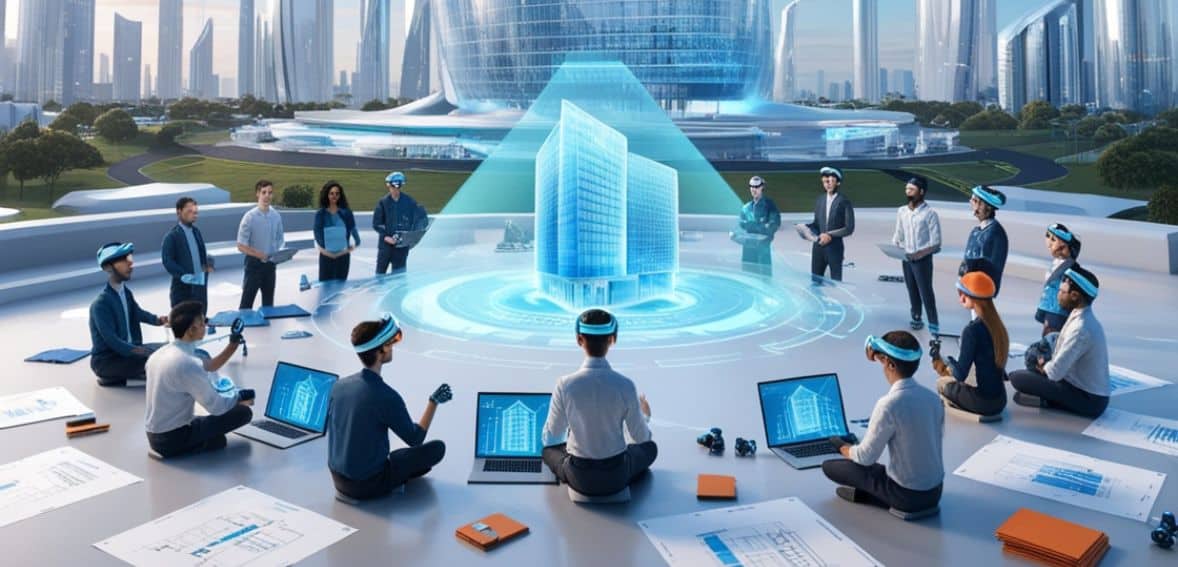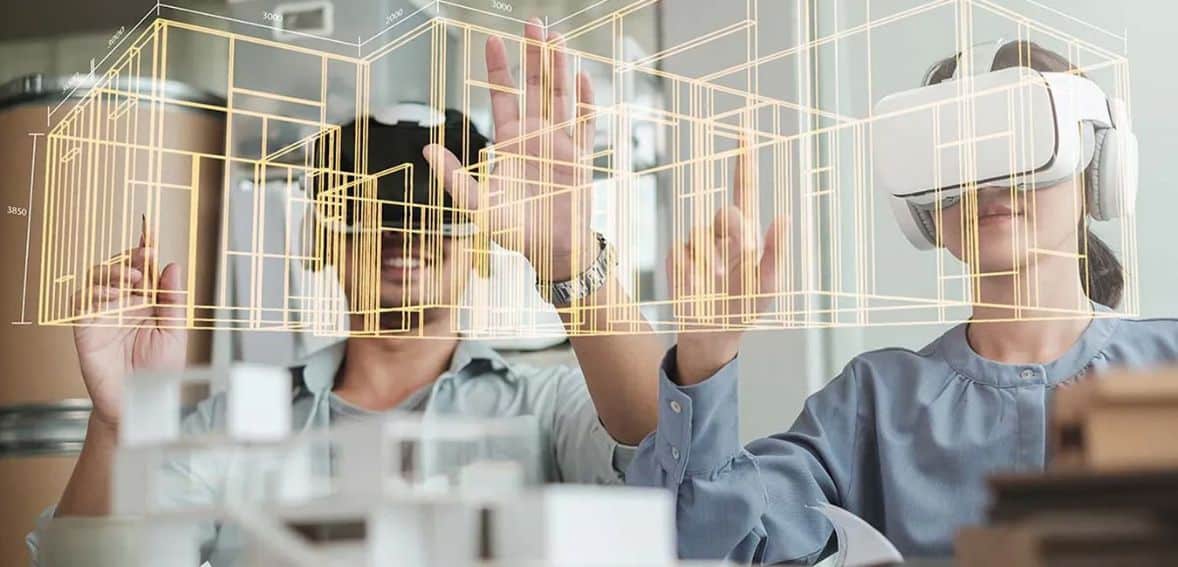The architecture and construction industries are undergoing a massive transformation, thanks to cutting-edge technologies like Building Information Modeling (BIM), Virtual Reality (VR), and Artificial Intelligence (AI). These innovations are revolutionizing the way buildings are designed, planned, and executed, making the process more efficient, precise, and collaborative.
Traditional design methods often relied on static blueprints and manual drafting, which left room for misinterpretation and inefficiencies. But today, architects and engineers can leverage BIM’s data-driven approach to create intelligent 3D models that go beyond aesthetics—they integrate crucial details like material performance, energy efficiency, and long-term adaptability.
In this article, we explore how BIM, VR, and AI are shaping the future of architecture and construction, the benefits they bring, and the challenges that need to be tackled to make these technologies a standard in the industry.
The Digital Revolution In Architectural Design

Technology has completely transformed the way architects approach design, making digital tools an essential part of the creative and construction process. Gone are the days of static blueprints—today, architecture is dynamic, data-driven, and highly collaborative.
At the heart of this shift is Building Information Modeling (BIM), a game-changing technology that allows architects, engineers, and contractors to work together in real-time. BIM doesn’t just create 3D models—it integrates crucial data like energy efficiency, material performance, and future adaptability, helping teams make informed decisions at every stage of a project.
Advancements in AI-powered design tools and computer-aided design (CAD) software further enhance this process, allowing for smarter, more precise, and efficient workflows. Architects can now simulate lighting conditions, predict environmental impact, and explore modifications long before construction begins.
Understanding BIM and Virtual Reality In Architecture

Building Information Modeling (BIM) is more than just 3D modeling—it’s a smart, data-driven approach to designing, constructing, and managing buildings throughout their entire lifecycle. By integrating detailed project information into a digital model, BIM allows architects, engineers, and contractors to collaborate seamlessly, reducing errors and improving efficiency.
From structural elements to energy performance, every aspect of a building can be planned, analyzed, and optimized before construction even begins.
Virtual Reality (VR) takes this a step further by immersing users in a fully interactive 3D environment. Instead of viewing blueprints or static models, stakeholders can step into a virtual space, walk through rooms, and experience the design in real-time.
This not only enhances client presentations but also helps identify potential design flaws early in the process.
Together, BIM and VR are reshaping the way buildings are designed and constructed, making the process more efficient, collaborative, and user-friendly.
Key Benefits of Combining BIM and Virtual Reality

Bringing Designs to Life
One of the biggest advantages of integrating BIM with Virtual Reality is the ability to step inside a design before construction even begins. Instead of relying on static 3D models or traditional blueprints, stakeholders can walk through a fully immersive digital space, experiencing the layout, lighting, and functionality in real time. This helps eliminate misunderstandings and ensures the final structure aligns with the client’s vision.
Smoother Construction Processes
By merging BIM and VR, teams can detect potential design clashes early, refine layouts, and simulate construction phases before breaking ground. This proactive approach helps minimize errors, optimize workflows, and ultimately speed up project completion.
Better Client Involvement
Not everyone can interpret technical drawings or 3D renderings on a screen. VR changes that by offering an interactive experience where clients can explore their future space firsthand. This leads to clearer communication, faster decision-making, and higher client satisfaction.
Stronger Team Collaboration
With a shared virtual model, architects, engineers, and contractors can work together more efficiently. VR enhances coordination, reduces misinterpretations, and helps teams stay on the same page throughout the project.
Saving Time and Money
BIM and VR technology help identify design flaws early, reducing the need for expensive rework and last-minute changes. By catching potential issues before construction starts, projects stay on budget and on schedule, making the entire process more cost-effective.
By combining the analytical power of BIM with the immersive experience of VR, construction projects become more efficient, collaborative, and client-focused.
Artificial Intelligence: Transforming Architectural Design

Artificial Intelligence (AI) is redefining the way architects conceptualize, plan, and execute designs. By leveraging AI-powered tools, architects can analyze vast amounts of data, optimize building layouts, and predict performance outcomes with greater accuracy.
AI enables designers to simulate environmental factors such as natural light, airflow, and energy consumption, allowing for the creation of more sustainable and energy-efficient buildings. This data-driven approach helps architects make informed decisions that improve both functionality and environmental impact.
One of AI’s most powerful capabilities is generative design—where algorithms generate multiple design variations based on predefined criteria. This allows architects to explore innovative, unconventional solutions that might not have been considered using traditional methods.
Additionally, AI-driven tools like Building Information Modeling (BIM) enhance collaboration between architects, engineers, and contractors. By integrating real-time data and automating design processes, AI reduces errors, streamlines workflows, and ensures a more cohesive project execution from start to finish.
AI in Construction Design vs. Traditional Design Approaches

Artificial Intelligence (AI) is reshaping construction design by leveraging data analytics and predictive modeling to enhance accuracy and efficiency. AI-driven tools analyze vast datasets, anticipate potential challenges, and optimize design layouts, helping architects and engineers make informed decisions before construction even begins.
In contrast, traditional design methods rely heavily on an architect’s expertise, experience, and manual drafting. While this approach allows for creative flexibility, it often requires time-consuming adjustments and revisions, especially when accommodating unforeseen challenges.
AI automates and refines key design processes, accelerating the creation of CAD drawings, shop drawings, and 3D models. Generative AI takes this a step further by producing multiple design variations based on parameters like space, materials, and budget—giving architects more options to explore without starting from scratch.
When integrated with Building Information Modeling (BIM), AI enables real-time updates and seamless collaboration between teams, ensuring design modifications are instantly reflected across all project stakeholders. Traditional construction design, on the other hand, often struggles with coordination, requiring manual updates and communication, which can slow down project timelines.
By bridging the gap between data-driven precision and creative design, AI is making construction processes smarter, faster, and more efficient, while traditional methods still hold value for their craftsmanship and hands-on expertise.
The Benefits of Artificial Intelligence In Construction Design

Artificial intelligence is revolutionizing the construction and architectural landscape, pushing the boundaries of what’s possible in design and project execution. According to Autodesk’s 2024 State of Design & Make Survey, 72% of AEC (Architecture, Engineering, and Construction) organizations have increased their investment in AI-driven technologies, experiencing noticeable improvements in efficiency and accuracy.
Here’s how AI is transforming construction design:
1. Generative Design Unlocks Limitless Possibilities
AI-powered generative design enables architects to explore countless design variations by simply optimizing factors like cost, space, and materials. Instead of manually sketching multiple iterations, AI algorithms generate optimized layouts, maximizing energy efficiency,sustainability, and occupant comfort.
Additionally, AI can seamlessly convert 2D floor plans into precise 3D models with up to 95% accuracy, significantly speeding up the design process while ensuring fewer errors.
2. Automation Reduces Repetitive Work
AI streamlines architectural workflows by automating tedious and repetitive tasks, reducing the margin for human error and freeing up professionals to focus on innovation. From project scheduling to resource allocation, AI-driven tools optimize operations, making design and construction more efficient.
3. Smarter Planning, More Efficient Designing
AI enhances project visualization by analyzing complex datasets and generating highly accurate 3D models and simulations.
For example, in BIM (Building Information Modeling) projects, AI can detect potential clashes between structural, electrical, and plumbing systems before construction even begins. This proactive approach prevents costly rework and delays, ensuring a smoother build process.
4. AI-Powered Risk Assessment
AI-driven drones and image recognition technology provide real-time site analysis, generating detailed 3D point clouds for accurate scan-to-BIM processes. Additionally, by analyzing past project data, AI predicts potential risks and shifts construction planning from reactive to proactive, allowing teams to mitigate issues before they escalate.
5. Personalized & Innovative Designs
AI is pushing architectural creativity to new heights by challenging traditional design constraints. Architects can now experiment with intricate detailing, dynamic forms, and complex geometries that were once too difficult or time-consuming to execute.
By leveraging AI, the industry is not only producing visually striking structures but also designing buildings that are smarter, more efficient, and built to stand the test of time.
Challenges and Solutions for Adopting BIM & VR In Construction
While Building Information Modeling (BIM) and Virtual Reality (VR) are transforming the construction industry, their adoption comes with certain challenges. However, with the right strategies, these hurdles can be effectively addressed.
High Initial Costs
Instead of a full-scale rollout, companies can gradually implement BIM & VR, starting with pilot projects to spread costs over time.
Resistance to Change
Employees may be hesitant to adopt new technologies. Workshops and hands-on training sessions can demonstrate the practical benefits of BIM & VR, helping teams feel more comfortable
Lack of Skilled Workforce
The industry needs more professionals proficient in these tools. Collaborating with universities, offering internships, and providing in-house training can help bridge the skill gap.
Data Integration Issues
Different software solutions often struggle to communicate. Using standardized formats and cloud-based platforms can ensure smoother data exchange.
Software Compatibility Problems
Not all BIM and VR tools work seamlessly together. Selecting interoperable software solutions ensures that data flows freely between different systems
Limited Stakeholder Engagement
Some stakeholders may not fully understand the value of these technologies. Using VR for interactive presentations can make complex designs more accessible and engaging.
Data Security Concerns
With large amounts of project data being shared digitally, security is a major concern. Implementing encryption, access controls, and cybersecurity best practices can safeguard sensitive information.
Regulatory Compliance Challenges Construction projects must adhere to strict regulations. Collaborating with industry bodies and staying updated on compliance requirements ensures BIM and VR adoption aligns with legal standards.
Overcoming the Barriers to Innovation
By addressing these challenges with strategic solutions, the construction industry can fully leverage BIM and VR to enhance efficiency, reduce costs, and improve project outcomes. The key is a phased approach, continuous learning, and strong collaboration to ensure long-term success.
Conclusion
The integration of BIM, VR, and AI is transforming architecture and construction, making the design process more intelligent, collaborative, and efficient. These technologies enhance visualization, streamline workflows, and reduce costly errors, ultimately leading to smarter, more sustainable buildings. While challenges like cost and adoption barriers exist, strategic implementation and industry-wide collaboration can bridge the gap. As the industry continues to evolve, embracing these innovations will be key to creating the next generation of architectural excellence.

Leave a Reply